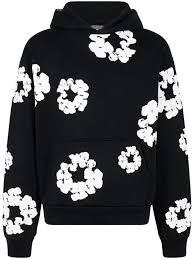Explore Denim Tears Germany: Fashion Rooted in History

In the world of contemporary fashion, few brands have managed to blend cultural storytelling with design as powerfully as Denim Tears. Founded by Tremaine Emory, Denim Tears has risen beyond the realm of mere clothing and entered the space of cultural archive, emotional expression, and social awareness. While the denim tears brand originated in the United States and is deeply intertwined with African American history, its reach has extended far beyond, including a significant cultural presence in Germany. Here, Denim Tears is not only appreciated for its aesthetic appeal but also for its depth, meaning, and story—a story that resonates in a country that has its own complex relationship with history.
The Meaning Behind Denim Tears
To understand the impact of Denim Tears in Germany, one must first look at what the brand represents. Denim Tears is not just a fashion label; it’s a narrative woven into cotton, denim, and fleece. Each collection explores history, identity, and struggle—most famously, through its use of the cotton wreath motif, which represents the legacy of enslaved African Americans forced to pick cotton during centuries of exploitation. Tremaine Emory uses clothing as historical text, forcing viewers and wearers alike to look deeper, engage thoughtfully, and participate in an ongoing journey of cultural reflection.
This historical context is especially important because Denim Tears is not only about the past. It speaks to the ongoing relationship between fashion and the human story, showing us that what we wear can be political, emotional, and deeply personal.
A Cultural Bridge Between America and Germany
Germany’s relationship with Denim Tears is rooted in the nation’s recognition of the importance of memory. Just as the brand reflects on the trauma and triumphs of African American history, Germany too exists in a space where the weight of its past is acknowledged as part of its identity. There is a shared cultural understanding of how history shapes the present.
In recent years, streetwear in Germany has evolved into a thoughtful cultural movement. Consumers have become increasingly aware, not only of the brands they choose, but of their stories—and the stories they choose to associate themselves with. Denim Tears fits naturally into this landscape. It has become popular particularly among younger generations, creatives, and those who value depth in design and meaning in their wardrobe.
Denim Tears in the German Fashion Scene
Streetwear in Germany is far from just casual clothing. It has become an emotional space where art, music, history, and social identity collide. Denim Tears sits alongside labels like Off-White, Supreme, and local German innovators—but it stands out for its moral and historical grounding. Every piece communicates something bigger, something beyond the wearer.
The brand’s presence is felt not only in stores and wardrobes but in conversations about what fashion should represent. Germany’s urban fashion hubs—Berlin, Hamburg, and Frankfurt—have embraced Denim Tears collections as symbolic artifacts. Fashion enthusiasts in these cities understand that wearing Denim Tears is not a trend; it is a statement. A refusal to forget. A celebration of resilience. A reminder of what came before.
Symbolism That Speaks Across Borders
One of the most defining characteristics of Denim Tears is its symbolism. In Germany, symbols carry weight—both caution and meaning. Denim Tears uses symbols the way history uses memory, embedding truths into the material world.
The cotton wreath is the most recognizable symbol from the brand. While it originates in American history, Germany has a cultural sensitivity to remembrance that allows this symbol to be understood rather than merely worn. It translates across oceans and across narratives. It reminds both wearer and observer that fashion is not just about fabric—it is about the soul beneath the surface.
In Germany, where many have learned to treat history not as a blockage but as a lesson, Denim Tears finds fertile ground. The brand serves as an invitation to reflect, learn, and acknowledge. Even for those who do not share the history of African American struggle, there is a universal resonance in wearing something that honors truth and legacy.
Art, Activism, and Clothing
Denim Tears is fashion, yes—but it is also activism. This is not activism through slogans but activism through design. It is rooted in the belief that storytelling can change how we see the world. The collections are not passive. They provoke thought. They challenge systems. They ask the wearer to think about who they are, what they represent, and how history influences the present moment.
In Germany, there has been a significant push from artists, educators, and activists to make space for conversations about colonialism, racism, and identity. Denim Tears supports that movement by offering something physical to wear, something that embodies cultural questions and emotional truths. This aligns deeply with the rise of cultural responsibility in German creative spaces.
Limited Drops and Cultural Demand
Part of what fuels Denim Tears’ popularity in Germany is its rarity. Unlike mass-produced fashion, many Denim Tears collections are released in limited drops or collaborations, making them not only symbolically meaningful but physically exclusive. This scarcity mirrors how cultural memory itself works—precious, limited, not always accessible, something to be handled with care.
The brand’s collaborations have included standout moments with Levi’s, Dior, and Converse—each adding another layer to the story. When these collections reach Germany, they are met with interest that goes beyond the clothes themselves. They become collectible pieces, often treated as art. In German cultural spaces—fashion studios, galleries, museums—Denim Tears pieces have been displayed not simply as clothing, but as historical commentary.
A Future Built on Reflection
Fashion is often seen as forward movement—trend to trend, season to season. But Denim Tears doesn’t exist within that system. It moves through time differently, looking both backward and forward at once. This is part of what makes its presence in Germany so meaningful. Germany too holds a dual sense of time, always in dialogue with its past, always envisioning a better future.
The success of Denim Tears in Germany is not a coincidence. It is a result of a deeper cultural readiness to embrace complexity, honor Denim Tears Hoodie struggle, and celebrate identity. It shows that fashion can be more than self-expression—it can be historical recognition.
As German youth continue to explore identity in an increasingly multicultural society, brands like Denim Tears will only become more important. They offer not just style, but context. Not just clothing, but connection.
Conclusion: Why Denim Tears Matters in Germany
Denim Tears is more than a label—it is a cultural experience. In Germany, where history itself is part of daily consciousness, the brand finds an audience ready to listen, learn, and wear meaning with pride. It reminds us that clothing can educate. It can heal. It can speak the truths that textbooks sometimes forget to tell.
In a world where fashion is often fast, temporary, and disposable, Denim Tears stands as a reminder that some things are meant to last. Not just fabric. Not just trends. But memory. Identity. Story.
Denim Tears in Germany represents a bridge—between nations, between histories, between people. It proves that even through thread and dye, we can stitch together something that speaks to our deepest truths.





